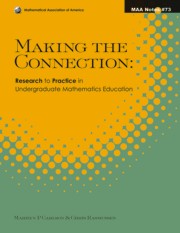Book contents
- Frontmatter
- Preface
- Contents
- Part 1 Student Thinking
- 1a Foundations for Beginning Calculus
- 1b Infinity, Limit and Divisibility
- 5 Developing Notions of Infinity
- 6 Layers of Abstraction: Theory and Design for the Instruction of Limit Concepts
- 7 Divisibility and Transparency of Number Representations
- 1c Proving Theorems
- 8 Overcoming Students' Difficulties in Learning to Understand and Construct Proofs
- 9 Mathematical Induction: Cognitive and Instructional Considerations
- 10 Proving Starting from Informal Notions of Symmetry and Transformations
- 11 Teaching and Learning Group Theory
- 12 Teaching for Understanding: A Case of Students' Learning to Use the Uniqueness Theorem as a Tool in Differential Equations
- Part 2 Cross-Cutting Themes
- About the Editors
10 - Proving Starting from Informal Notions of Symmetry and Transformations
from Part 1 - Student Thinking
- Frontmatter
- Preface
- Contents
- Part 1 Student Thinking
- 1a Foundations for Beginning Calculus
- 1b Infinity, Limit and Divisibility
- 5 Developing Notions of Infinity
- 6 Layers of Abstraction: Theory and Design for the Instruction of Limit Concepts
- 7 Divisibility and Transparency of Number Representations
- 1c Proving Theorems
- 8 Overcoming Students' Difficulties in Learning to Understand and Construct Proofs
- 9 Mathematical Induction: Cognitive and Instructional Considerations
- 10 Proving Starting from Informal Notions of Symmetry and Transformations
- 11 Teaching and Learning Group Theory
- 12 Teaching for Understanding: A Case of Students' Learning to Use the Uniqueness Theorem as a Tool in Differential Equations
- Part 2 Cross-Cutting Themes
- About the Editors
Summary
In this chapter we consider the challenge of promoting students' ability to develop their own proofs of geometry theorems. We have found that students can make use of transformations and symmetries of geometric figures to gain insight into why a particular theorem is true. These insights often have the potential to form the basis for rigorous proofs. In the following classroom vignette, we see the excitement that comes from discovering an idea that seems to explain exactly why a theorem is true, followed by the realization that there is significant work to be done in order to develop a rigorous proof based on such an idea.
Classroom Vignette
Setting: A college geometry class using the Henderson (2001) text has been asked to work in groups to prove the isosceles triangle theorem (ITT). That is, given two sides of a triangle are congruent, prove that the angles opposite those sides are congruent. After about 3 minutes without much progress, the group of Alice, Emily, and Valerie burst into activity.
Alice: The book says to use symmetries.
Emily: Symmetries?
Valerie: That angle equals that angle —
Alice: Okay! Yeah! Yeah.
Valerie: And then this angle —
Alice: If you have, yeah! If you have, like, a bisected angle —
Emily: You do the angle bisector —
Alice: Yeah! And then this matches this [rotates her right hand from palm-up to palm-down across her triangle drawing] because it can lay right on top of it! [Moves her left hand to land (at word “top”) on palm-up right hand.] Because then you like rotate it.
Information
- Type
- Chapter
- Information
- Making the ConnectionResearch and Teaching in Undergraduate Mathematics Education, pp. 125 - 138Publisher: Mathematical Association of AmericaPrint publication year: 2008
Accessibility standard: Unknown
Why this information is here
This section outlines the accessibility features of this content - including support for screen readers, full keyboard navigation and high-contrast display options. This may not be relevant for you.Accessibility Information
- 4
- Cited by
